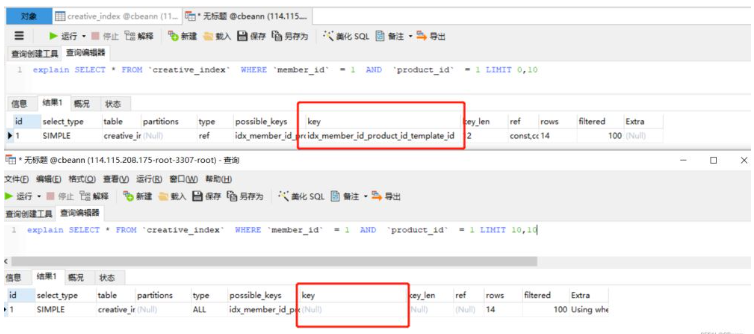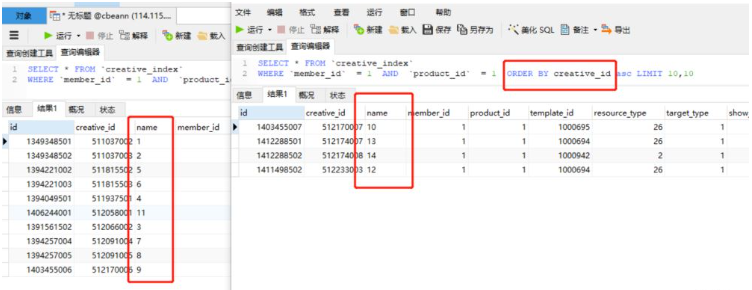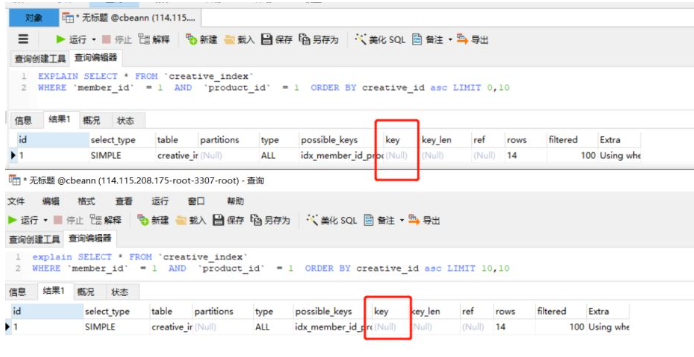How to use limit query method in mysql
Background
Recently, during project joint debugging, a bug in paging query was discovered. Page query always has data that cannot be found or is found repeatedly.
The database has a total of 14 records.

If you follow 10 items per page. Then the query SQL sum results of the first page and the second page are as follows.
Then here comes the problem. When querying the first and second pages, records of 11, 12, and 13 appear , and does not appear 4 Record. Why can’t I always find data? ? ?

SQL
DROP TABLE IF EXISTS `creative_index`; CREATE TABLE `creative_index` ( `id` bigint(20) NOT NULL COMMENT 'id', `creative_id` bigint(20) NOT NULL COMMENT 'creative_id', `name` varchar(256) DEFAULT NULL COMMENT 'name', `member_id` bigint(20) NOT NULL COMMENT 'member_id', `product_id` int(11) NOT NULL COMMENT 'product_id', `template_id` int(11) DEFAULT NULL COMMENT 'template_id', `resource_type` int(11) NOT NULL COMMENT 'resource_type', `target_type` int(11) NOT NULL COMMENT 'target_type', `show_audit_status` tinyint(4) NOT NULL COMMENT 'show_audit_status', `bound_adgroup_status` int(11) NOT NULL COMMENT 'bound_adgroup_status', `gmt_create` datetime NOT NULL COMMENT 'gmt_create', `gmt_modified` datetime NOT NULL COMMENT 'gmt_modified', PRIMARY KEY (`id`), KEY `idx_member_id_product_id_template_id` (`member_id`,`product_id`,`template_id`), KEY `idx_member_id_product_id_show_audit_status` (`member_id`,`product_id`,`show_audit_status`), KEY `idx_creative_id` (`creative_id`) ) ENGINE=InnoDB DEFAULT CHARSET=utf8mb4 COMMENT='测试表'; -- ---------------------------- -- Records of creative_index -- ---------------------------- INSERT INTO `creative_index` VALUES ('1349348501', '511037002', '1', '1', '1', '1000695', '26', '1', '7', '0', '2023-03-16 22:12:56', '2023-03-24 23:38:49'); INSERT INTO `creative_index` VALUES ('1349348502', '511037003', '2', '1', '1', '1000695', '26', '1', '7', '1', '2023-03-16 22:15:29', '2023-03-24 21:23:33'); INSERT INTO `creative_index` VALUES ('1391561502', '512066002', '3', '1', '1', '1000695', '26', '1', '7', '0', '2023-03-23 23:37:34', '2023-03-24 21:24:04'); INSERT INTO `creative_index` VALUES ('1394049501', '511937501', '4', '1', '1', '1000942', '2', '1', '0', '0', '2023-03-24 14:00:46', '2023-03-25 15:19:37'); INSERT INTO `creative_index` VALUES ('1394221002', '511815502', '5', '1', '1', '1000694', '26', '1', '7', '0', '2023-03-23 17:00:41', '2023-03-24 21:23:39'); INSERT INTO `creative_index` VALUES ('1394221003', '511815503', '6', '1', '1', '1000694', '26', '1', '3', '0', '2023-03-23 17:22:00', '2023-03-24 21:23:44'); INSERT INTO `creative_index` VALUES ('1394257004', '512091004', '7', '1', '1', '1000694', '26', '1', '7', '0', '2023-03-23 17:23:21', '2023-03-24 21:24:11'); INSERT INTO `creative_index` VALUES ('1394257005', '512091005', '8', '1', '1', '1000694', '26', '1', '3', '0', '2023-03-23 17:31:05', '2023-03-25 01:10:58'); INSERT INTO `creative_index` VALUES ('1403455006', '512170006', '9', '1', '1', '1000694', '26', '1', '0', '0', '2023-03-25 15:31:02', '2023-03-25 15:31:25'); INSERT INTO `creative_index` VALUES ('1403455007', '512170007', '10', '1', '1', '1000695', '26', '1', '0', '0', '2023-03-25 15:31:04', '2023-03-25 15:31:28'); INSERT INTO `creative_index` VALUES ('1406244001', '512058001', '11', '1', '1', '1000694', '26', '1', '3', '0', '2023-03-23 21:28:11', '2023-03-24 21:23:56'); INSERT INTO `creative_index` VALUES ('1411498502', '512233003', '12', '1', '1', '1000694', '26', '1', '0', '0', '2023-03-25 14:34:37', '2023-03-25 17:00:24'); INSERT INTO `creative_index` VALUES ('1412288501', '512174007', '13', '1', '1', '1000694', '26', '1', '7', '0', '2023-03-25 01:11:53', '2023-03-25 01:12:34'); INSERT INTO `creative_index` VALUES ('1412288502', '512174008', '14', '1', '1', '1000942', '2', '1', '0', '0', '2023-03-25 11:46:44', '2023-03-25 15:20:58');
Solution to the problem
As can be seen from the query results, the query results are obviously not sorted according to a certain column (verychaos).
Then is it enough to add a sorting rule?? With the attitude of giving it a try, it really worked out.

Analysis problem
Why limit query will appear without adding order byPaging query always has data that cannot be found or is found repeatedly? Is there an implicit order sorting?
At this timeexplain appears.

The index has two functions: retrieval and sorting
Because the two SQLs use different indexes (sorting rules) , the above problem will occur when the index limit is released, and the problem is solved.
The above is the detailed content of How to use limit query method in mysql. For more information, please follow other related articles on the PHP Chinese website!

Hot AI Tools

Undresser.AI Undress
AI-powered app for creating realistic nude photos

AI Clothes Remover
Online AI tool for removing clothes from photos.

Undress AI Tool
Undress images for free

Clothoff.io
AI clothes remover

AI Hentai Generator
Generate AI Hentai for free.

Hot Article

Hot Tools

Notepad++7.3.1
Easy-to-use and free code editor

SublimeText3 Chinese version
Chinese version, very easy to use

Zend Studio 13.0.1
Powerful PHP integrated development environment

Dreamweaver CS6
Visual web development tools

SublimeText3 Mac version
God-level code editing software (SublimeText3)

Hot Topics
 PHP's big data structure processing skills
May 08, 2024 am 10:24 AM
PHP's big data structure processing skills
May 08, 2024 am 10:24 AM
Big data structure processing skills: Chunking: Break down the data set and process it in chunks to reduce memory consumption. Generator: Generate data items one by one without loading the entire data set, suitable for unlimited data sets. Streaming: Read files or query results line by line, suitable for large files or remote data. External storage: For very large data sets, store the data in a database or NoSQL.
 How to use MySQL backup and restore in PHP?
Jun 03, 2024 pm 12:19 PM
How to use MySQL backup and restore in PHP?
Jun 03, 2024 pm 12:19 PM
Backing up and restoring a MySQL database in PHP can be achieved by following these steps: Back up the database: Use the mysqldump command to dump the database into a SQL file. Restore database: Use the mysql command to restore the database from SQL files.
 How to optimize MySQL query performance in PHP?
Jun 03, 2024 pm 08:11 PM
How to optimize MySQL query performance in PHP?
Jun 03, 2024 pm 08:11 PM
MySQL query performance can be optimized by building indexes that reduce lookup time from linear complexity to logarithmic complexity. Use PreparedStatements to prevent SQL injection and improve query performance. Limit query results and reduce the amount of data processed by the server. Optimize join queries, including using appropriate join types, creating indexes, and considering using subqueries. Analyze queries to identify bottlenecks; use caching to reduce database load; optimize PHP code to minimize overhead.
 How to insert data into a MySQL table using PHP?
Jun 02, 2024 pm 02:26 PM
How to insert data into a MySQL table using PHP?
Jun 02, 2024 pm 02:26 PM
How to insert data into MySQL table? Connect to the database: Use mysqli to establish a connection to the database. Prepare the SQL query: Write an INSERT statement to specify the columns and values to be inserted. Execute query: Use the query() method to execute the insertion query. If successful, a confirmation message will be output.
 How to create a MySQL table using PHP?
Jun 04, 2024 pm 01:57 PM
How to create a MySQL table using PHP?
Jun 04, 2024 pm 01:57 PM
Creating a MySQL table using PHP requires the following steps: Connect to the database. Create the database if it does not exist. Select a database. Create table. Execute the query. Close the connection.
 How to use MySQL stored procedures in PHP?
Jun 02, 2024 pm 02:13 PM
How to use MySQL stored procedures in PHP?
Jun 02, 2024 pm 02:13 PM
To use MySQL stored procedures in PHP: Use PDO or the MySQLi extension to connect to a MySQL database. Prepare the statement to call the stored procedure. Execute the stored procedure. Process the result set (if the stored procedure returns results). Close the database connection.
 How to fix mysql_native_password not loaded errors on MySQL 8.4
Dec 09, 2024 am 11:42 AM
How to fix mysql_native_password not loaded errors on MySQL 8.4
Dec 09, 2024 am 11:42 AM
One of the major changes introduced in MySQL 8.4 (the latest LTS release as of 2024) is that the "MySQL Native Password" plugin is no longer enabled by default. Further, MySQL 9.0 removes this plugin completely. This change affects PHP and other app
 The difference between oracle database and mysql
May 10, 2024 am 01:54 AM
The difference between oracle database and mysql
May 10, 2024 am 01:54 AM
Oracle database and MySQL are both databases based on the relational model, but Oracle is superior in terms of compatibility, scalability, data types and security; while MySQL focuses on speed and flexibility and is more suitable for small to medium-sized data sets. . ① Oracle provides a wide range of data types, ② provides advanced security features, ③ is suitable for enterprise-level applications; ① MySQL supports NoSQL data types, ② has fewer security measures, and ③ is suitable for small to medium-sized applications.






